Vincent Audio SV-200 Integrated Amplifier
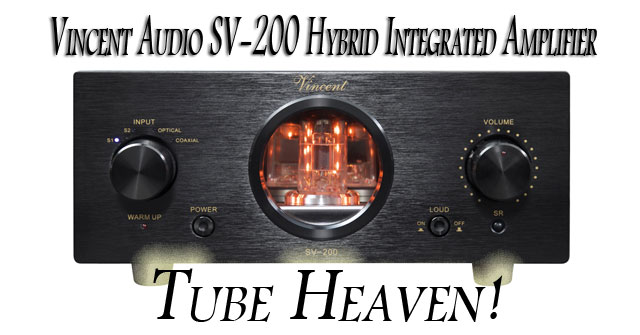
 I met Adam Sohmer at Capital Audio Fest 2019. His company, Sohmer Associates, is the PR rep for Vincent Audio, a successful German brand that does terrific things in consumer audio. Brooklyn-based Sohmer Assoc and I spoke about potentially doing a review on Vincent gear. We agreed upon the SV-200 Hybrid Integrated amplifier, the subject of this review.
I met Adam Sohmer at Capital Audio Fest 2019. His company, Sohmer Associates, is the PR rep for Vincent Audio, a successful German brand that does terrific things in consumer audio. Brooklyn-based Sohmer Assoc and I spoke about potentially doing a review on Vincent gear. We agreed upon the SV-200 Hybrid Integrated amplifier, the subject of this review.
Upon its arrival, I was surprised how petite the shipping box was. I placed the 16.75″ x10.5″ x5″ box on its side, cut the shipping straps, and opened the fold-out top, revealing customized packing foam, a small box for the remote on the left, another small box on the right which contained necessary cables and cords. I lifted the top foam off and saw the amp neatly snuggled within a drawstring cloth bag. The box is made well and reusable and comes in handy as I transported the integrated to numerous destinations during this review.


After reading the brochure instructions, I installed the remote battery (which took a good push to in-seat properly). The remote is built from brushed aluminum, with rubber-coated buttons, and it has a nice heft to it. It’s offered controls for Vincent Audio CD players with your typical navigation buttons. You can also select Source 1, Source 2, optical, and coax. The bottom + and – buttons control the volume of the amp. Included in the box were a standard A.C. power cord, a set of RCA interconnects, a short optical cable, and a mini-jack cable. All appear of good quality.
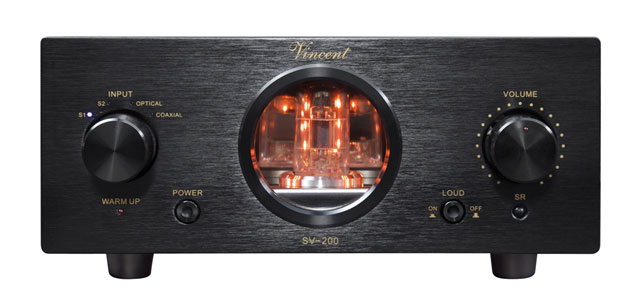
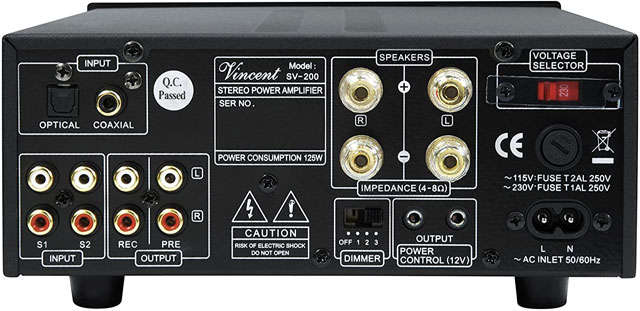
Say Hello to Vincent
Every once in a while, something comes your way that is a real show stopper, and the Vincent SV-200 is just that. The face plate’s design won me over, with its gorgeous, round and beveled center window that sports two tubes, flanked by two selector and volume knobs and two smaller buttons for power and loudness. The Vincent SV-200 is a hybrid design, combining a Class-D output stage with a two 6N1 vacuum tube input stage. This little wonder of a line stage provides connections for digital sources and even contains a built-in DAC. The SV-200 delivers 25 watts per channel into 8 ohms and 35 watts into 4 ohms and measures just 11.75″ deep x 8.25″ wide and stands 3.75″ high. A welcomed footprint for today’s tight spaces. It retails for $799.95.
Set up
 With my install complete, I decided to use my pair of Pioneer PP-BS22-LR’s monitors, designed by Andrew Jones. They have a sensitivity of 85 dB and optimized to have a more improved efficient power input. I mounted them on 24″ metal stands filled with steel shot, using my banana terminated cables… but, at first, could not push them in. After close inspection, I found that there were small rubber pieces in the holes of the amp jacks. Hmm. I referred to the brochure again, Ahh! I Missed the part where you have to pull out the small rubber shipping plugs! The bananas then installed smoothly. To my delight, as I pressed the power button, a beautiful warm orange glow emitted from the center display window where the tubes are mounted. On the amp’s rear are four settings for illumination window brightness. The brochure mentioned the amp needs some time to burn in, so let the burn in begin!
With my install complete, I decided to use my pair of Pioneer PP-BS22-LR’s monitors, designed by Andrew Jones. They have a sensitivity of 85 dB and optimized to have a more improved efficient power input. I mounted them on 24″ metal stands filled with steel shot, using my banana terminated cables… but, at first, could not push them in. After close inspection, I found that there were small rubber pieces in the holes of the amp jacks. Hmm. I referred to the brochure again, Ahh! I Missed the part where you have to pull out the small rubber shipping plugs! The bananas then installed smoothly. To my delight, as I pressed the power button, a beautiful warm orange glow emitted from the center display window where the tubes are mounted. On the amp’s rear are four settings for illumination window brightness. The brochure mentioned the amp needs some time to burn in, so let the burn in begin!
 After a few hours, I powered down the amp and connected my music source, an Apple 13″ MacBook Pro playing through iTunes, using the Amara Luxe App. I wanted to join the laptop to the optical connection on the amp using the supplied cable, but I needed a mini Jack end to connect to the Mac. Luckily, I had a 15′ optical cable with a mini-jack on one end and a standard Toslink jack on the other. I placed the SV-200 on the brick hearth of our 16′ x 13′ x 9′ prewar NYC apartment’s railroad-style front room and switched it on. When the unit is powered up, the amber light of the volume knob blinks for about 20 seconds or so. Once stable, you’re ready to play.
After a few hours, I powered down the amp and connected my music source, an Apple 13″ MacBook Pro playing through iTunes, using the Amara Luxe App. I wanted to join the laptop to the optical connection on the amp using the supplied cable, but I needed a mini Jack end to connect to the Mac. Luckily, I had a 15′ optical cable with a mini-jack on one end and a standard Toslink jack on the other. I placed the SV-200 on the brick hearth of our 16′ x 13′ x 9′ prewar NYC apartment’s railroad-style front room and switched it on. When the unit is powered up, the amber light of the volume knob blinks for about 20 seconds or so. Once stable, you’re ready to play.
The remote handily makes volume adjustments (quite quickly) in increments of 0 to 20 as I pressed the remote’s volume to bring the listening volume up to the desired level, indicated by a small orange LED (that’s located on the knob itself). I noticed that the amp’s volume knob physically turns as the remote commands it. Very cool! I did a test, turning the amp off for a few minutes before powering it back up. The music came back on at the same volume level where I left it, so it remembers the volume setting.
Listening Part 1
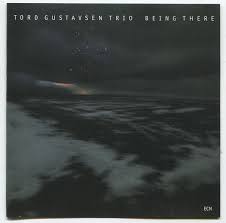 I thought I’d start with a piano trio, the Tord Gustavsen Trio, be exact, with the album, “Being There” (2006, ECM.) With the first track, At Home, the piano Immediately enters with clear percussiveness. There’s excellent detail here – you can hear the harmonics around the notes – and the song exudes a sense of calm that implores that you pay attention to the song’s rather methodical structure. With Harald Johnsen on bass and Jarle Vespestad on drums, this trio paints a beautiful atmosphere. A little history, Tord holds a degree in psychology, later studying and teaching Jazz theory. The trio works so very well together. The SV-200 filled the room with detail and stride. Despite its 25 watts into 8 ohms of power, this integrated amp seems to have a lot of headroom. The midrange is warm, producing great detailed highs and a surprising full bottom end.
I thought I’d start with a piano trio, the Tord Gustavsen Trio, be exact, with the album, “Being There” (2006, ECM.) With the first track, At Home, the piano Immediately enters with clear percussiveness. There’s excellent detail here – you can hear the harmonics around the notes – and the song exudes a sense of calm that implores that you pay attention to the song’s rather methodical structure. With Harald Johnsen on bass and Jarle Vespestad on drums, this trio paints a beautiful atmosphere. A little history, Tord holds a degree in psychology, later studying and teaching Jazz theory. The trio works so very well together. The SV-200 filled the room with detail and stride. Despite its 25 watts into 8 ohms of power, this integrated amp seems to have a lot of headroom. The midrange is warm, producing great detailed highs and a surprising full bottom end.
Misguided Angel, from the Cowboy Junkies album, “Studio, Selected Songs From 1985-1995,” (RCA), a greatest hits compilation, is a great place to land. The simple instrumentation of harmonica, accordion, steadily-strummed guitar, and vocals are accompanied by a welcomed tape hiss and all the sonics you’ll ever want. Margo Timmins’ haunting voice sounds so sweet on this “Best Of” recording. You can even hear someone’s foot-tapping in the background. The drums and cymbals appeared effortless, and I enjoyed every sonic note.
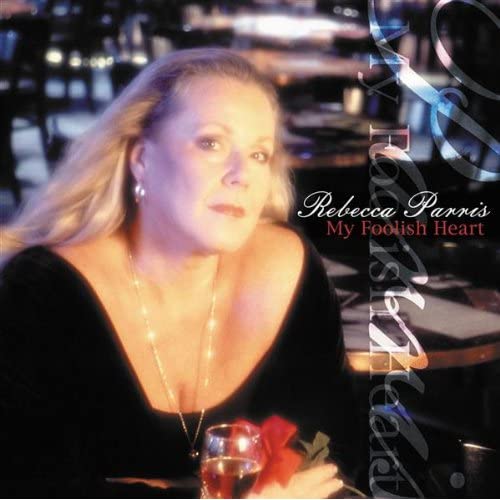 Up next, I chose the title song from Rebecca Parris’ album, “My Foolish Heart,” (2001, Koch Jazz KOC-CD-7887). Parris’ voice has graced the records of such well-known artists as Count Basie, Buddy Rich, Winton Marsalis, and many others. This album will stand the test of time for her velvety vocals and style. Accompanied with a beautiful arrangement, composed by Victor Young with lyrics by Ned Washington, lilts its way from beginning to end. Rebecca renders this song correctly through the Vincent amp. As I turned the volume up a bit, the loudspeakers almost disappeared, the amp showed no strain at all—just pure music.
Up next, I chose the title song from Rebecca Parris’ album, “My Foolish Heart,” (2001, Koch Jazz KOC-CD-7887). Parris’ voice has graced the records of such well-known artists as Count Basie, Buddy Rich, Winton Marsalis, and many others. This album will stand the test of time for her velvety vocals and style. Accompanied with a beautiful arrangement, composed by Victor Young with lyrics by Ned Washington, lilts its way from beginning to end. Rebecca renders this song correctly through the Vincent amp. As I turned the volume up a bit, the loudspeakers almost disappeared, the amp showed no strain at all—just pure music.
Switching to “Nocturne, The Piano Album” by Vangelis (Decca Records, 2019) Moonlight Reflections, you hear the gently paced keyboard notes, joined by an ethereal mix of other sounds. A sense of calm washed over me as the music swelled. It’s nice to hear Vangelis presented merely with this album. Vincent continues to impress. Warm and natural is the key here.
Listening Part 2
Like I said before, the shipping box comes in handy. I transported the Vincent amp to my weekend house in C.T., where I have a room set up for audio downstairs. I put the amp on a small stand and used the same laptop as my source, but this time I played through a pair of Spica TC-50 speakers. The minimum needed to drive these speakers is 25 watts, and this amp, rated at 25 watts into 8 Ohms. Let’s go!
 First up was Sting’s A Thousand Years from “Brand New Day” (A&M Records 1999)- with a play of this first track, you know this was a well-recorded project. From the quiet lead-in, you notice a low bass rumble. Wow, that was unexpected! The orchestral strings are nicely rendered. A single rim shot and cymbal cadence is established. Sting’s layered vocal is right there with loads of space and air. The Vincent did well! Very enjoyable. With a play of “Big Lie Small World,” from the same album, I loved the Bossa Nova-style guitar lead-in. The piano and maracas were very tactful and extremely clear. Sting’s voice is recorded somewhat intimately and with great tonal character. Chris Botti’s muted trumpet is well-placed in the mix.
First up was Sting’s A Thousand Years from “Brand New Day” (A&M Records 1999)- with a play of this first track, you know this was a well-recorded project. From the quiet lead-in, you notice a low bass rumble. Wow, that was unexpected! The orchestral strings are nicely rendered. A single rim shot and cymbal cadence is established. Sting’s layered vocal is right there with loads of space and air. The Vincent did well! Very enjoyable. With a play of “Big Lie Small World,” from the same album, I loved the Bossa Nova-style guitar lead-in. The piano and maracas were very tactful and extremely clear. Sting’s voice is recorded somewhat intimately and with great tonal character. Chris Botti’s muted trumpet is well-placed in the mix.
I decided to play with the amp’s loudness button. Notably, It does add a little more bass without that typical bloomy sound. While not very efficient at 84dB, the Spica could use a bit of help in the low end and typically low an outstanding amount of power. Still, the Vincent produced sweet solid sound through inventor John Baugh’s babies.
With Boz Scaggs’ album “But Beautiful- Standards- Vol.1” (Gray Cat Records 2003), What’s New was up next. I love the light drums and cymbals to start. Boz’s voice is surprisingly forward, and it elevates this recording as the musicians linger. The detail is stunning, and this amp hangs right in there, shooting back at you every nuance.
Listening Part 3
 To make things interesting, I transported the amp once again to Jersey City to Greg Voth, (my brother-in-law and a fellow contributor) to their reasonably ample loft space with 13′ ceilings. The speakers that command this space are Tekton Double Impact floor standers. They have a 98.82dB efficiency and a 4 Ohm load, so that will push the Vincent to the output of 35 WPC. We disconnected his Dynamique Audio Tempest 2 speaker cables from his amp and substituted the Vincent SV-200. Using my same laptop as the music source, we were then good to go.
To make things interesting, I transported the amp once again to Jersey City to Greg Voth, (my brother-in-law and a fellow contributor) to their reasonably ample loft space with 13′ ceilings. The speakers that command this space are Tekton Double Impact floor standers. They have a 98.82dB efficiency and a 4 Ohm load, so that will push the Vincent to the output of 35 WPC. We disconnected his Dynamique Audio Tempest 2 speaker cables from his amp and substituted the Vincent SV-200. Using my same laptop as the music source, we were then good to go.
The first artist played was Luther Vandross, from his album “Secret Love” (Epic 1990). The song was No Body to Love. Wow! The punch and detail were over the top. Luther’s voice filled the 24 rafters in the space. You could hear the harmonics in both the vibes and guitars. Vincent offered a challenge with Greg’s far more expensive amp that threw us for a loop.
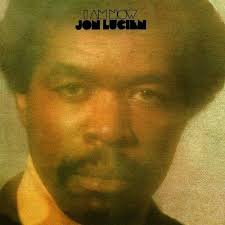 Jon Lucien’s debut album, “I Am Now” (RCA 1970), his rendition of Dindi, is glorious. You can hear his Island accent – Jon is from the British Virgin Islands and raised in St.Thomas. We could not believe the presentation as it was so big for such a sweet and intimate song. Ultra-low bass notes were emitting from the Tektons and what depth! Lots of it. This little Vincent amp is delivering that much? Yes, it is! Music was just swirling around our heads. Greg and I played various other songs, from jazz to chamber music, and the SV-200 performed with ease.
Jon Lucien’s debut album, “I Am Now” (RCA 1970), his rendition of Dindi, is glorious. You can hear his Island accent – Jon is from the British Virgin Islands and raised in St.Thomas. We could not believe the presentation as it was so big for such a sweet and intimate song. Ultra-low bass notes were emitting from the Tektons and what depth! Lots of it. This little Vincent amp is delivering that much? Yes, it is! Music was just swirling around our heads. Greg and I played various other songs, from jazz to chamber music, and the SV-200 performed with ease.
Conclusion
Smartly designed, the Vincent SV-200 fits today’s digital and analog sources seamlessly. Its sound output is much bigger than I expected – rich and detailed with a touch of warmth, I especially like its design and small footprint. This little amp exceeded expectations for its price point in every way. If you’re in the market for well-priced, authentic high-end performance gear that’s easily portable, the Vincent SV-200 is a fantastic place to start. Glad I met you, Vincent. Highly recommended!


Tim Barrall
Specifications:
Price: $799
Frequency response: 20 Hz – 20 kHz ±0,5 dB
Nominal Output Power at 8 Ω: 2 x 25 W (RMS)
Nominal Output Power at 4 Ω: 2 x 35 W (RMS)
Input sensitivity: 220 mV
Total Harmonic Distortion: < 0.1 % (1 kHz, 1 W)
Signal to Noise Ratio: > 72 dB
Input Impedance: 47 kΩ
Maximum power consumption: 125 watts
Dimensions (W x H x D): 210 x 95 x 320 mm
Weight: 5 kg, 11.023 lbs.
Contact:
Pangea Audio Distributing
PR Agent: Adam Sohmer
(347) 662 6535
Tim’s Associated Equipment:
Core Power Technologies Equi=Core 1800 (mains filter)
Counterpoint PAC-5 (mains filter)
Audio Path power cord
Kimber Kable “Silver Streak” interconnects
Synergistic Alpha Quad speaker cables
Dynamique Audio Tempest 2 speaker cable
Monster “Power Line series 3” speaker cable
KabelDirekt optical Mini Toslink cable
Pioneer BP22-LR speakers
Spica TC-50 speakers
Tekton Double Impact speakers
One thought on "Vincent Audio SV-200 Integrated Amplifier"
Leave a Reply
Stereo Times Masthead
Publisher/Founder
Clement Perry
Editor
Dave Thomas
Senior Editors
Frank Alles, Mike Girardi, Russell Lichter, Terry London, Moreno Mitchell, Paul Szabady, Bill Wells, Mike Wright, and Stephen Yan,
Current Contributors
David Abramson, Tim Barrall, Dave Allison, Ron Cook, Lewis Dardick, John Hoffman, Dan Secula, Don Shaulis, Greg Simmons, Eric Teh, Greg Voth, Richard Willie, Ed Van Winkle, Rob Dockery, Richard Doran, and Daveed Turek
Site Management Clement Perry
Ad Designer: Martin Perry






Can you clarify the solid state output detail? The Vincent website says that it is a class AB. Also, can anyone provide details about the built-in DAC? The product info seems to be lacking these details.